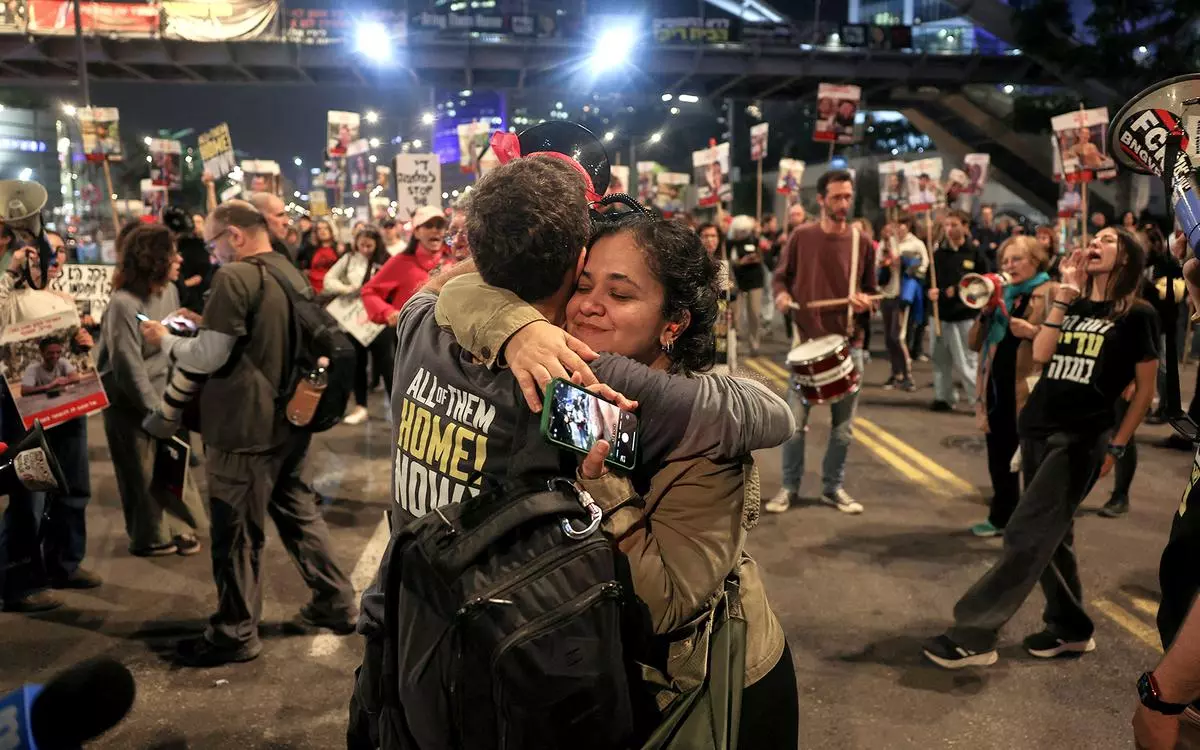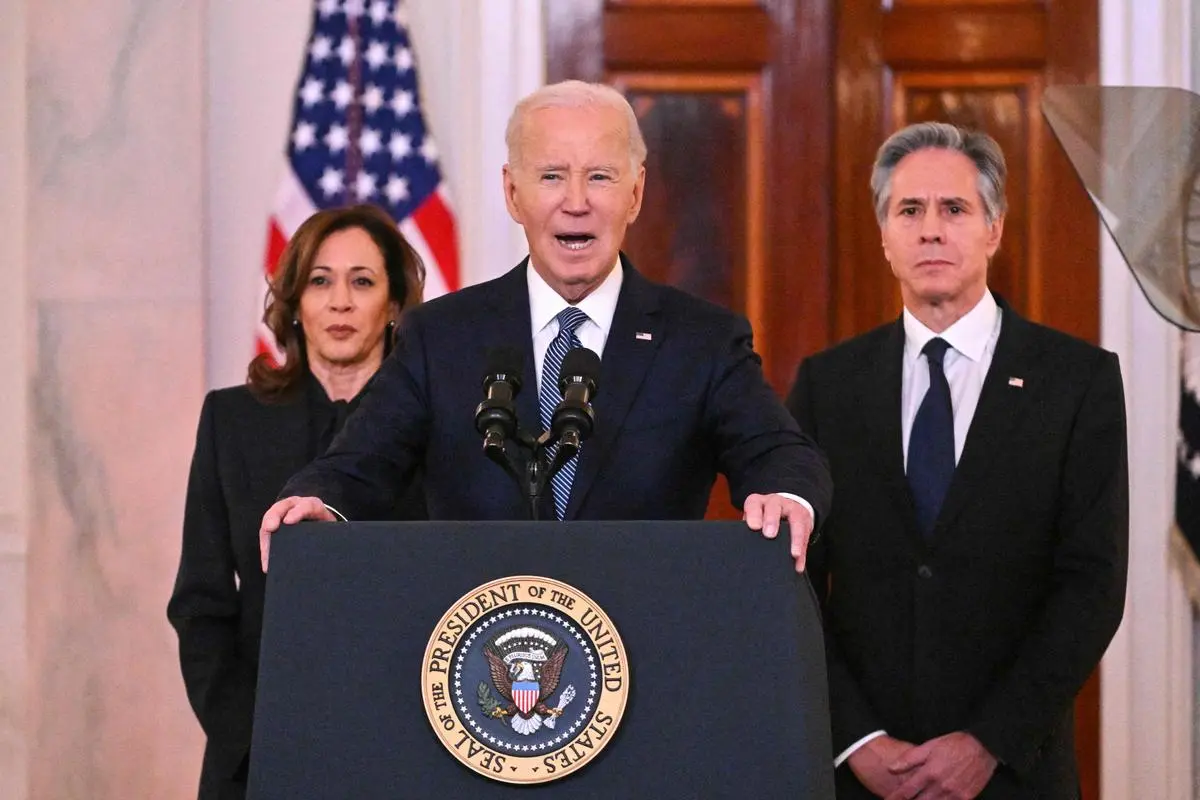In an unprecedented diplomatic breakthrough, Israel and Hamas have agreed to implement the ceasefire agreement, eight months after it was drafted and approved by the UN Security Council. This move marks a potential turning point in one of West Asia’s bloodiest conflicts in Gaza.
First proposed in May 2024 by US President Joe Biden, the ceasefire plan faced numerous political obstacles, primarily from Israeli Prime Minister Benjamin Netanyahu, who has been accused of modifying its terms and delaying its implementation for domestic and personal political gains.
Initially unveiled on May 31, 2024, the ceasefire outlined a three-phase resolution to the Gaza conflict. While the core framework remains unchanged, the political landscape has shifted significantly. The looming inauguration of US President-elect Donald Trump, known for his unpredictable approach and threats of a hardline stance, exerted pressure on both Israel and Hamas to act before his presidency begins.
David Hearst, a prominent expert on West Asian affairs, noted that Netanyahu’s resistance had frustrated his own negotiators in the past. “Netanyahu had become the main obstacle to a Gaza ceasefire, to the considerable frustration of his own negotiators,” he said.
Also Read | ‘The root of the problem is the occupation’: Moussa Abu Marzouk
The departure of Defense Minister Yoav Gallant, who had openly criticised the lack of military objectives left in Gaza, underscored the growing dissent within Israel’s leadership. Gallant had bluntly stated, “There is nothing left for the army to do in Gaza.”
Israeli pundits and analysts increasingly questioned the government’s handling of the war. Erel Segal expressed frustration, saying, “We thought we’d take control of northern Gaza, that they’d let us impede humanitarian aid.” Yossi Yehoshua, writing in Ynet, was equally critical: “There’s no need to sugarco at the reality: the emerging ceasefire and hostage release deal is bad for Israel, but it has no choice but to accept it.”
Phase one of the deal will last six weeks and include a “full and complete ceasefire, the withdrawal of Israeli forces from all the populated areas of Gaza, and the release of a number of hostages held by Hamas, including women, the elderly and the wounded”. In exchange, Israel will release “hundreds of Palestinian prisoners”.
During phase one, Palestinians “can also return to their neighbourhoods in all areas of Gaza” and humanitarian assistance will be surged into the enclave. “During the next six weeks, Israel will negotiate the necessary arrangements to get [to] phase two, which is a permanent end to the war.”
“There are a number of issues to negotiate to move from phase one to phase two, but the plan says that if negotiations take longer than six weeks, the ceasefire will continue as long as the negotiations continue.”

Supporters of Israeli hostages, who were kidnapped during the deadly October 7 2023 attack by Hamas, react to news on the Gaza ceasefire negotiations, during a protest to demand a deal to bring every hostage home, in Tel Aviv, Israel on January 15, 2025.
| Photo Credit:
RONEN ZVULUN
Here are the key components of the agreement:
Prisoner exchange
At the heart of the ceasefire deal is the exchange of prisoners. Hamas has agreed to release 33 Israeli prisoners during the first phase, prioritising women, children, and men over 50. These include soldiers, civilians, and dual nationals held prisoners since the October 7 attack.
In return, Israel will release about 2,000 Palestinian prisoners, including 250 who are serving life sentences. According to Hamas spokesperson Basem Naim, “This agreement reflects our commitment to alleviating the suffering of the Palestinian people and our steadfast pursuit of justice for those unlawfully imprisoned.”
The release process will unfold over six weeks, with three hostages being freed weekly. For each prisoner released, Israel will free dozens of Palestinian prisoners, ensuring a phased and balanced exchange.
Military de-escalation and withdrawal
The agreement includes a 42-day truce, during which Israel will initiate a phased military withdrawal from key positions in Gaza, including the Netzarim Corridor. Hamas has requested that Israeli forces retreat at least 700 meters from the Gaza border as a confidence-building measure.
Egypt and Qatar will oversee the withdrawal process to ensure compliance. Speaking to Al Jazeera, a Qatari official stated, “This is a fragile but vital step forward. We will ensure that both parties adhere to the terms and that displaced residents can return safely to their homes.”
Humanitarian aid and reconstruction
The ceasefire will allow for the delivery of much-needed humanitarian aid to Gaza, where hundreds of thousands have been displaced. The truce aims to create conditions for the safe return of residents to northern Gaza and other war-torn areas. “The destruction in Gaza is immense,” said Gaza’s Government Media Office in a statement. “Our priority is to rebuild and provide shelter, food, and medical care to those who have endured unimaginable suffering.”
Qatar and Egypt will coordinate with humanitarian organizations to facilitate the reconstruction of Gaza, ensuring international assistance reaches those in need.
Qatar’s Prime Minister Sheikh Mohammed bin Abdulrahman Al Thani announced that the ceasefire would commence on Sunday, January 19, but emphasized the fragility of the agreement. “This is a fragile but vital step forward,” he stated. Mediators have warned that the success of the deal hinges on unwavering commitment from both sides.
The agreement is the result of intense backchannel diplomacy that began in Doha earlier this month. Mediators from Qatar and Egypt, alongside U.S. officials, played a critical role in brokering the deal.
Even before the deal was announced in Doha, Trump took to his social media platform, Truth Social, writing, “WE HAVE A DEAL FOR THE HOSTAGES IN THE MIDDLE EAST. THEY WILL BE RELEASED SHORTLY. THANK YOU!”
Trump had made the hostage crisis a priority, repeatedly warning Hamas of severe consequences if the captives were not released before his inauguration on January 20. His Middle East envoy, Steve Witkoff, worked closely with President Joe Biden’s administration to expedite negotiations. “This is a turning point for the region,” said Witkoff. “The focus is now on implementation and ensuring that this agreement holds. Both sides have shown remarkable restraint in reaching this point.”
Overview
Ceasefire Agreement: Brokered by Israel, Qatar, and the United States.
Duration of Conflict: Over 460 days of war in Gaza.
First Phase (6 Weeks)
Prisoner Exchange:
Hamas: Releases 33 Israeli captives (women, children, civilians over 50).
Israel: Frees a larger number of Palestinian prisoners, including ~1,000 detained after October 7.
Israeli Military Withdrawal:
Troops retreat to no more than 700 metres inside Gaza’s border (excluding Netzarim Corridor).
Full withdrawal from the Philadelphi Corridor by the 50th day.
Humanitarian Aid:
Up to 600 trucks of aid are permitted daily.
Civilians allowed to return to northern Gaza.
Medical evacuations for wounded Palestinians.
Rafah crossing with Egypt reopened seven days after the phase starts.
Second Phase
Conditions:
Hamas to release all remaining captives (primarily male soldiers).
Israel to implement a “complete withdrawal” from Gaza.
Challenges:
Opposition from far-right Israeli cabinet members.
Negotiations to ensure the phase proceeds.
Third Phase
Key Proposals:
Exchange of captives’ bodies for a 3-5 year international reconstruction plan.
Governance Plan:
Interim authority led by the Palestinian Authority with international partners.
Short-term security forces from Arab states, conditional on a pathway to Palestinian statehood.
Disagreements remain over governance and the pathway to statehood.
Mediator Guarantees
Egypt, Qatar, and the US:
Verbal guarantees for continued negotiations.
Aim to ensure the implementation of all phases within six weeks.
Challenges Beyond the Ceasefire
Governance Uncertainty:
Debate over Gaza’s administration post-ceasefire.
US-backed interim authority faces resistance from Israeli lawmakers.
Pathway to Statehood:
Support from Arab states contingent on progress toward Palestinian statehood.
Israeli hesitations despite prior commitments in the Oslo Accords.

US President Joe Biden, alongside Vice President Kamala Harris and Secretary of State Antony Blinken, speaks about the Israel-Hamas ceasefire and hostage release deal on January 15, 2025.
| Photo Credit:
ROBERTO SCHMIDT/AFP
The war has taken a devastating toll, with over 46,000 Palestinians killed, the majority of whom were women and children, and widespread destruction across Gaza. Hostage releases remain a poignant aspect of the deal, with Hamas agreeing to free 33 hostages in the first phase and Israel reciprocating by releasing hundreds of Palestinian prisoners. Still, fewer than 100 hostages remain in Gaza, and a significant number are presumed dead.
Despite the international push for peace, domestic sentiment in Israel remains divided. Critics argue that the deal signifies a loss of leverage for Israel, with Netanyahu’s indecision and political manoeuvring undermining potential strategic gains.
Meanwhile, Hamas has portrayed the agreement as a victory for Palestinian resistance. Basem Naim, a spokesperson for Hamas, emphasized the group’s commitment to alleviating Palestinian suffering and achieving justice for prisoners.
“This agreement reflects our commitment to alleviating the suffering of the Palestinian people and our steadfast pursuit of justice for those unlawfully imprisoned,” he told Frontline.
While the ceasefire agreement offers a glimmer of hope, experts warn that the underlying issues fuelling the Israeli-Palestinian conflict remain unresolved. Awni Almashni of the Fatah movement highlighted the geopolitical shifts brought about by the war, including diminished US influence in the Red Sea and growing instability in the region.
Also Read | Exclusive: The inside story of the diplomatic manoeuvres that yielded Gaza ceasefire
President Biden, reflecting on the painstaking negotiations, called the ceasefire a “durable end to the war” and credited US-led diplomacy for the breakthrough. “My diplomacy never ceased in their efforts to get this done,” he said. “This is not just a ceasefire; it is a framework for peace and rebuilding.”
Experts say the success of the agreement will depend on its implementation and the goodwill of both parties. While the ceasefire offers a reprieve, challenges remain, including rebuilding trust and addressing the underlying issues fueling the conflict.
Future phases of the deal envision a complete Israeli withdrawal from Gaza, the release of remaining hostages and prisoners, and large-scale reconstruction efforts. Qatar and Egypt are expected to play a central role in ensuring that these objectives are met.
“This is not just a ceasefire,” said Sheikh Mohammed bin Abdulrahman bin Jassim Al Thani, Qatar’s Prime Minister. “It is a framework for peace and rebuilding. But it requires commitment and cooperation from all sides.”
For the millions affected by the conflict, the deal represents a vital first step toward healing and recovery. Yet, the question remains: can this fragile accord withstand the complexities of a region where change is the only constant? Only time will tell if this agreement marks the beginning of a lasting peace or merely a temporary pause in an endless cycle of violence.
